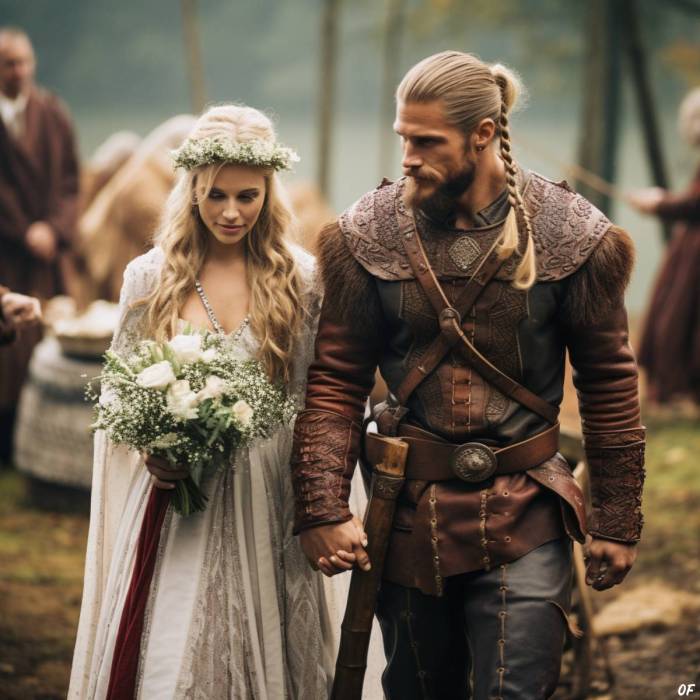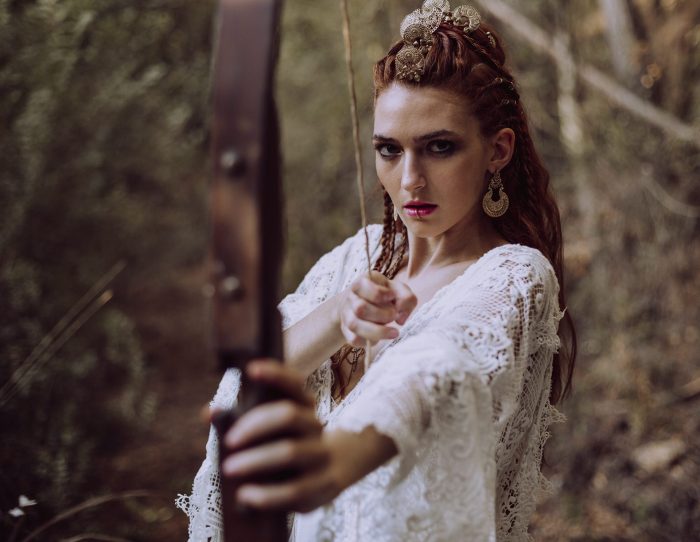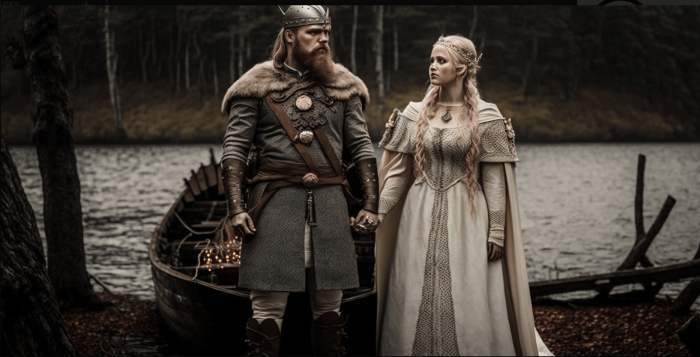Nordic Viking Wedding Dress: A Historical and Modern Exploration

Source: oddfeed.net
The allure of a Nordic Viking wedding dress stems from a captivating blend of history and contemporary design. This exploration delves into the historical accuracy of Viking-age attire, examines modern interpretations, and explores the accessories, setting, and color palettes that define this unique aesthetic.
Historical Accuracy of Nordic Viking Wedding Attire

Source: yolancris.com
Reconstructing a historically accurate Viking wedding dress requires understanding the materials, construction techniques, and social nuances of the Viking Age (roughly 8th-11th centuries CE). Limited extant garments provide clues, supplemented by archaeological finds and sagas.
Materials Used in Viking-Age Clothing: Wool was the primary fabric, sourced from sheep and often dyed using natural pigments from plants and insects. Linen, a finer fabric, was also used, particularly by the upper classes. Leather and fur provided warmth and durability, especially in colder climates.
So, you’re digging that fierce Nordic Viking wedding dress vibe? Totally get it, that historical badassery is on point. But maybe you’re thinking a more practical length? Check out these awesome options for knee length wedding dresses here if you want something a bit more chill for the reception. Then, just add some seriously cool Viking-inspired accessories and you’re golden, babe!
Construction Techniques: Viking-age clothing relied on simple yet effective techniques. Garments were often constructed from rectangular pieces of fabric, seamed together with hand-stitching. Embroidery and other decorative elements were added using wool or linen threads. The use of brooches and pins was crucial for fastening garments.
Social Class Differences: Clothing reflected social status. Wealthier women likely wore finer linens and more elaborate embellishments, including intricate embroidery and silver or gold brooches. Poorer women wore coarser wools and simpler designs. The quality and quantity of clothing were clear indicators of social standing.
Symbolic Meaning of Colors and Embellishments: While precise symbolic meanings are debated, certain colors and embellishments may have held significance. Deep reds and blues might have indicated status or power, while natural colors like browns and greys were more common. Embroidery and brooches could symbolize family lineage or personal identity.
Evolution of Viking-Age Women’s Attire:
| Period | Garment Style | Materials | Embellishments |
|---|---|---|---|
| Early Viking Age (8th-9th centuries) | Simple long tunics, possibly with a separate skirt | Wool, linen | Minimal, possibly woven patterns |
| Late Viking Age (10th-11th centuries) | More fitted tunics, possibly with sleeves and decorative borders | Wool, linen, some silk imports | Embroidery, brooches, beads |
Modern Interpretations of a Nordic Viking Wedding Dress
Modern designers draw inspiration from Viking-age clothing, creating contemporary wedding dresses that evoke a sense of history and artistry. This involves careful consideration of historical accuracy while adapting designs to modern sensibilities.
Examples of Modern Designs: Many modern dresses feature long, flowing silhouettes reminiscent of Viking tunics. Some incorporate traditional Viking motifs, such as knotwork or animal imagery, into the fabric design or embroidery. Others use natural fabrics and color palettes to capture the essence of the era.
Challenges and Opportunities: Translating historical designs into modern fashion requires balancing authenticity with wearability and comfort. The challenge lies in creating a design that is both historically inspired and aesthetically pleasing for a modern bride. The opportunity lies in reinterpreting historical motifs and techniques in a fresh and innovative way.
Incorporation of Traditional Motifs: Designers often use traditional Viking knotwork, animal imagery (such as ravens or wolves), and geometric patterns in embroidery, lace, or fabric printing to add historical authenticity.
Different Modern Interpretations: Modern interpretations range from minimalist designs with subtle nods to the Viking Age to highly elaborate gowns with extensive embroidery and intricate detailing. Some focus on the silhouette and fabric, while others prioritize embellishments and symbolic elements.
Key Design Elements:
- Long, flowing silhouette
- Natural fabrics (linen, wool, silk)
- Earthy color palettes (browns, greys, blues)
- Incorporation of Viking knotwork or other motifs
- Simple, elegant embellishments
Accessories and Adornments for a Nordic Viking Wedding Dress
Accessories play a crucial role in completing a Nordic Viking wedding dress. Traditional Viking jewelry and headpieces add authenticity and enhance the overall aesthetic.
Traditional Viking Jewelry: Brooches, often made of silver or bronze, were essential for fastening garments. Necklaces with amber, glass, or bone beads were also common. Rings and bracelets, sometimes adorned with intricate designs, completed the look.
Materials and Techniques: Authentic-looking Viking jewelry often uses traditional techniques such as filigree work and granulation. Materials include silver, bronze, amber, glass beads, and bone. Modern artisans often recreate these pieces, ensuring both historical accuracy and contemporary craftsmanship.
Symbolic Meaning of Jewelry: While precise meanings are often debated, certain jewelry pieces might have held symbolic value related to status, protection, or family lineage. Amber, for example, was believed to possess magical properties.
Visual Description of a Complete Outfit: Imagine a floor-length gown of deep blue wool, accented with subtle silver embroidery along the neckline and sleeves. A large silver brooch fastens the gown at the shoulder. A simple necklace of amber beads rests against the neckline. Silver bracelets adorn the wrists, and a silver ring graces the bride’s finger.
Potential Hair and Headpiece Styles:
- Braided hairstyles, possibly adorned with beads or ribbons
- A simple circlet or headband made of silver or other metal
- Loose, flowing hair, possibly with floral accents
The Setting and Context of a Nordic Viking Wedding
Viking-age weddings were likely informal ceremonies, emphasizing community and family bonds. The setting and atmosphere would have been influenced by the season and the couple’s social standing.
Typical Setting and Atmosphere: Weddings might have taken place in a longhouse or outdoors, depending on the weather and the resources available. The atmosphere was likely festive, with feasting, drinking, and music playing a central role.
Social Customs and Traditions: While specific details are scarce, weddings likely involved a betrothal ceremony, followed by a feast and celebration. Family and community played an important role in the proceedings, signifying the importance of social ties.
Role of Family and Community: Family and community were essential to Viking weddings. The event served as a means to strengthen social bonds and demonstrate the couple’s integration into the wider community. The presence of family and friends signified support and acceptance.
Influence of Environment and Seasonality: The time of year might have influenced attire choices. Heavier fabrics and furs would have been appropriate for winter weddings, while lighter materials might have been chosen for warmer months. The setting – indoors or outdoors – would also have affected attire choices.
A crisp autumn day bathed the longhouse in golden light. The bride, radiant in a deep blue wool gown adorned with silver embroidery, stood beside her groom. Her long hair, intricately braided, was accented with a simple silver circlet. The air buzzed with excitement as family and friends gathered, their laughter and conversation mingling with the crackling fire and the sounds of traditional music. The feast that followed was a joyous celebration, a testament to the couple’s union and the strength of their community.
Color Palettes and Fabrics for a Modern Nordic Viking Wedding Dress

Source: viking.style
Choosing appropriate colors and fabrics is key to achieving an authentic yet modern Nordic Viking aesthetic. The focus should be on natural materials and color palettes that evoke the era’s essence.
Significance of Natural Dyes and Fabrics: Viking-age clothing relied on natural dyes derived from plants and insects, resulting in a limited yet beautiful range of colors. These natural dyes often had a subtle, muted quality that complements the earthy tones of the era.
Color Palettes: Earthy tones like deep blues, greens, browns, and greys are particularly suitable. Subtle accents of ivory or cream can add contrast. Avoid bright, artificial colors that would clash with the historical aesthetic.
Textures and Drape of Fabrics: Natural fabrics such as linen, wool, and silk offer a luxurious drape and texture that is appropriate for a wedding gown. The choice of fabric should complement the design and the overall aesthetic.
Comparison of Modern Fabrics: Modern bridal fabrics like silk charmeuse, crepe, or even heavier wool crepe can be excellent choices for a Viking-inspired design. The key is to choose fabrics that have a natural look and feel and drape well.
Mood Board Description: Imagine a mood board featuring swatches of deep blue wool crepe, ivory silk charmeuse, and a textured linen in a muted grey. These are accompanied by smaller swatches of natural dyes, such as a deep reddish-brown from madder root and a soft yellow-green from weld. The overall impression is one of earthy elegance and understated luxury.
FAQ Insights
What are some modern fabric choices that evoke a Viking aesthetic?
Linen, wool, and silk are excellent choices, mimicking the natural fibers used historically. Modern blends incorporating these materials can offer comfort and durability.
How can I incorporate Viking symbolism without being overly literal?
Subtle nods to Viking knotwork, runes (perhaps subtly embroidered), or nature-inspired motifs (like ravens or wolves) can add a touch of Viking influence without being costume-like.
Are there specific colors associated with Viking weddings?
While definitive evidence is scarce, earthy tones like deep greens, browns, and blues, along with natural ivory or off-white, would reflect the available dyes and natural materials of the time.
Where can I find inspiration for a Nordic Viking-inspired wedding setting?
Consider locations with natural beauty – forests, meadows, or even a rustic barn – to evoke the atmosphere of a Viking-age celebration. Incorporating natural elements into your décor will further enhance the theme.
